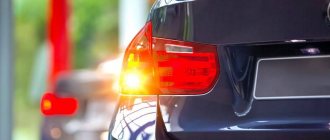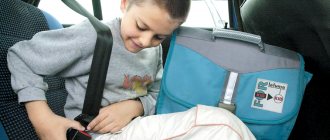HomeArticlesReflectors for pedestrians: desire or obligation?
The roadway is a place of increased danger, despite the installation of road signs. Therefore, all road users must observe the necessary safety measures. Statistics show that every second emergency situation on city roads is a collision with pedestrians. Since a greater number of such incidents occur in conditions of insufficient lighting, the presence of reflective elements is mandatory, which is enshrined in the law of the Russian Federation dated July 1, 2015.
Reflective elements (RE) are capable of refracting light fluxes incident on them. This feature of the SE allows the driver to improve the view of the road and respond in a timely manner to an obstacle on it. When the light flux hits the solar cell, the reflected beam is directed to the headlights of the vehicle and ensures the visibility of the pedestrian even in unfavorable conditions (darkness, fog, rain).
When using clothing with reflective materials or other elements with such properties, the risk of accidents involving pedestrians is significantly reduced. Thus, the use of SE allows the driver to notice people walking along the roadway (and sometimes pets) already at a distance of 200 meters with low beam headlights, and at a distance of 350 meters with high beam headlights. This will allow you to reduce your speed and safely avoid an emergency. Also, in the dark, noticeable LED road signs and reflectors have a positive effect on the situation on the road.
Types of reflective elements
Depending on the reflection angle, SEs can be:
- Wide angle (more efficient).
- Narrow angle.
For solar cells to perform their function, light must fall on them at an optimal angle of incidence (40 degrees) or close to it. To increase the likelihood of effective operation of SEs, it is necessary to distribute them over different parts of the body (arms, back, legs) so that they are as clearly visible to the driver as possible.
The shape of reflective elements is available in the form:
- Stripes (sewn onto clothes or glued with an iron).
- Key rings and pendants (hang on backpacks, satchels, bags).
- Thermal stickers or adhesive stickers.
- Badges (attached to clothing).
Stickers, patches and other similar elements should be applied to visible places so that they are anatomically located on parts of the body.
If you do not have similar options for reflective accessories and clothing with sewn-in reflectors on hand, you can provide protection by applying spray paint with a light reflection effect.
Special glass lenses or reflective surfaces in the manufacture of SCs increase their efficiency due to guaranteed good refractive properties.
You can wear bright yellow vests with sewn reflectors. The presence of such vests is especially important for drivers. When going out on the highway at night, they also become pedestrians and are at risk.
The best colors for reflective stripes and other devices used for these purposes are: white, light gray and bright yellow-green (lemon). Outerwear in light colors will also increase a person's visibility on the roadway.
There are elements with built-in LEDs or light bulbs. They glow on their own, without the need for light rays to hit them. There are also options with special coatings (for example, phosphorus-containing), which allows them to be used for signal in the dark.
In the absence of alternative solutions, battery-powered flashlights can be used to ensure pedestrian safety. They should be carried in such a way that they are clearly visible to the driver, but they do not blind him.
Attention! Laser elements are strictly prohibited, as they can blind the driver and cause a traffic accident.
GOST R 12.4.219-99 regulates the quality of materials for reflectors.
Concept and types of reflective elements
Reflective elements (hereinafter referred to as RRE) are aimed at reflecting all the light falling on them in order to prevent a traffic accident by increasing the driver’s visibility of the roadway and the presence of obstacles on it.
They can take different forms:
- stickers (can be attached to clothing with Velcro);
- thermal strips (attached to fabric by heating with an iron);
- rigid bracelets (twisted, attached to an arm, leg or bag);
- pendants;
- keychains;
- icons;
- laces.
When light hits a reflective element, the beam from it is directed towards the light source.
In the case of road traffic, these are car headlights. It should be noted that the optimal angle of light at which the reflective element will work is 40 degrees. There are several types of UHE depending on the angle of reflection - wide-angle (angle is about 50 degrees) and narrow-angle (angle is about 25 degrees). Of course, wide-angle elements are more effective in use. Since the angle of incidence of light may vary depending on the direction of travel of the vehicle, the VEs should be evenly distributed on all sides of the pedestrian's body. If a pedestrian does not have the opportunity to purchase professional light-emitting diodes, then they can also be easily made at home by applying special reflective paint from a spray can to the required surface. In general, the quality of reflective materials produced in Russia must meet GOST R 12.4.219-99. When officially selling products made from such materials, a quality certificate must be present.
The optimal colors for SVE are:
- citric;
- white;
- light grey.
Materials of other colors may also have reflective characteristics, but they will be much lower (for example, if we take the reflectivity of white as 100%, then for example, for red it is already 40%). self-illuminating ones are also often used . They work in the dark, regardless of whether light hits them. If UHEs simply reflect the beam that hits them back to its source, then this type essentially emits light on its own. This effect is achieved through materials such as fluorescent paint, phosphor, LEDs or battery-powered light bulbs.
The thing is that a laser beam of even low intensity, especially green, has a blinding effect on the driver. And instead of preventing accidents, lasers rather provoke them. In Russia, the use of lasers within the roadway is not regulated by law at all. However, pedestrians must remember that by ignoring common sense and using lasers on the road for fun, they are, first of all, putting their own lives at risk.
How many reflectors should there be and their location
There are standards for the number of SEs. GOST R 51835-2001 regulates their locations.
Elements that reflect light are arranged as follows:
- On the legs (legs) horizontally in the lower or middle part, or vertically on the outside.
- On the arms (sleeves) along the outer line of the shoulder and/or forearm, across the upper or lower third.
- On the back horizontally along the lower and upper parts, or along the shoulder line down parallel to each other or in a V-shape.
- In front along the chest line or under it, or vertically from the shoulder line to the bottom.
- On the body in the form of suspenders.
It is advisable that SEs be on hats, bags, backpacks, knapsacks, gloves, and shoes. It’s good when there are several elements in different places. If there is only one reflector, then it must be of sufficient size (at least a quarter of square meters according to GOST) and located on the headdress or chest. This will increase the likelihood that the driver will notice a person on the road. But it is better to have two or more reflective elements. Such protection turns out to be reliable in practice, capable of identifying a pedestrian.
Bicycles, scooters, strollers, and wheelbarrows must also be equipped with an electric vehicle. Adhesive tape with a reflective coating is suitable for this. It is necessary to paste it over the pedestrian’s vehicle so that its dimensions are clear. Persons riding a bicycle or scooter on a road, its edge or shoulder should wear appropriate reflective equipment. Or you need to use any available methods of applying SE to clothing (in the form of patches or stickers), and also use flickers (for example, bracelets, key chains). You can wear a vest with SE.
If appropriate special sleeves are used as reflective elements, they should be worn so that they are clearly visible to vehicle drivers, provided the headlights are on, at a distance of up to four hundred meters.
When moving along the roadway with a pet (this is especially true when a pedestrian is walking with a dog or cat), you need to put on a leash, harness, overalls or any possible cape with reflectors.
The concept and types of reflective elements on clothing. consultation (grade 5) on the topic
Concept and types of reflective elements.
Reflective elements are aimed at reflecting all the light falling on them in order to prevent a traffic accident by increasing the driver’s visibility of the road surface and the presence of obstacles on it.
They can take different forms: stickers (can be attached to clothing with Velcro); thermal strips (attached to fabric by heating with an iron); rigid bracelets (twisted, attached to an arm, leg or bag); pendants; keychains; icons; laces. When light hits a reflective element, the beam from it is directed towards the light source. In the case of road traffic, these are car headlights. It should be noted that the optimal angle of light at which the reflective element will work is 40 degrees. There are several types of UHE depending on the angle of reflection - wide-angle (angle is about 50 degrees) and narrow-angle (angle is about 25 degrees). Of course, wide-angle elements are more effective in use.
Since the angle of incidence of light may vary depending on the direction of travel of the vehicle, the VEs should be evenly distributed on all sides of the pedestrian's body. If a pedestrian does not have the opportunity to purchase professional light-emitting diodes, then they can also be easily made at home by applying special reflective paint from a spray can to the required surface.
The optimal colors for SVE are: lemon; white; light grey. Materials of other colors may also have reflective characteristics, but they will be much lower (for example, if we take the reflectivity of white as 100%, then for example, for red it is already 40%). In addition to reflective elements, self-illuminating ones are also often used. They work in the dark, regardless of whether light hits them. If UHEs simply reflect the beam that hits them back to its source, then this type essentially emits light on its own.
The thing is that a laser beam of even low intensity, especially green, has a blinding effect on the driver. And instead of preventing accidents, lasers rather provoke them. In Russia, the use of lasers within the roadway is not regulated by law at all. However, pedestrians must remember that by ignoring common sense and using lasers on the road for fun, they are, first of all, putting their own lives at risk.
Children on the road
The safety of children should be given special attention. Introducing children to the rules of the road is the direct responsibility of adults. It is necessary to ensure the protection of the child in all available ways.
For children, you should purchase clothes, backpacks and satchels with sewn-in solar cells. If they are not available, you must use tape, bracelets, stickers, key rings and other devices with reflective coatings. Especially popular among kids and teenagers are bracelets (they look like a fashion accessory) and badges (any design can be applied to them).
It is necessary to instruct the child about the rules of behavior on the roadway. Children's educational institutions usually conduct classes on this topic.
For schoolchildren, GOST regulates certain sizes of reflective tape. It must be at least 5 centimeters wide and a total length of two meters.
When reflectors are required
According to amendments to the traffic rules dated July 1, 2015, reflective elements are mandatory for pedestrians in conditions of insufficient lighting (darkness) and poor visibility (fog, rain) when crossing and/or driving along the roadway, its edge or shoulder outside populated areas.
As for the movement of pedestrians in the dark along the road zone of populated areas, wearing clothing and items with reflectors is recommended.
There is no specific time period corresponding to the concept of “darkness”. But it is believed that this is the period from sunset to sunrise.
In terms of requirements, movement during fog and other weather conditions when visibility is insufficient is equal to this.
Fines for violation of requirements
If a pedestrian does not comply with the indicated rules and does not use reflective elements during periods of insufficient visibility (darkness and fog) outside the territories of populated areas, a fine for violation of the requirements is imposed in the amount of 500 rubles. The same fine is imposed on the driver if he had to get out of the vehicle in poor visibility conditions.
Sometimes things that seem insignificant at first glance can save lives. This is exactly what reflective elements are. By following simple rules and basic requirements, you can ensure protection and minimize the risk of accidents on the roads.
Fine for lack of reflective clothing on pedestrians and drivers.
To the delight of all drivers who are tired of being scared by the sudden appearance of a pedestrian on the road in poor visibility conditions, from July 1, 2015, all pedestrians moving on the side of the road or on a road outside a populated area were required to wear reflective clothing or reflective elements in the form of badges, pendants, bracelets, ribbons If this rule is violated, the pedestrian caught will receive a fine of 500 rubles.
A pedestrian whose reflective element on clothing is not visible or is difficult to see will pay the same fine. According to the rules, the reflective element must be located as high as possible on a person’s clothing and be at least 25 square centimeters in size.
On December 12, 2021, a decree was issued obliging a driver forced to get out of a car in conditions of poor visibility outside a populated area to wear clothing containing reflective elements. If this rule is not followed, the driver faces a fine of 500 rubles.
According to modern rules, it is allowed to use a 50% discount to pay a fine within 20 days from the date of receipt.










